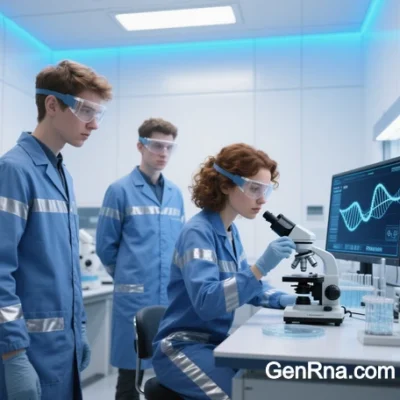 Structural Dynamics, Catalytic Process, and Regulatory Control
Structural Dynamics, Catalytic Process, and Regulatory Control
1. Introduction
RNA polymerase (RNAP) is the enzymatic cornerstone of transcription, the process by which genetic information encoded in DNA is transcribed into RNA. This complex molecular machine navigates the DNA template, synthesizes RNA through nucleotide polymerization, and ensures the faithful transmission of genetic instructions. This article elucidates the structural architecture, catalytic mechanism, and regulatory intricacies of RNAP-mediated transcription across prokaryotic and eukaryotic systems.
2. Structural Architecture of RNA Polymerase
A. Prokaryotic RNA Polymerase
Prokaryotic RNAP is a multi-subunit complex (α₂ββ’ω) coupled with a dissociable sigma (σ) factor that confers promoter specificity. The core enzyme (α₂ββ’ω) binds DNA non-specifically, while the σ factor recognizes conserved promoter elements such as the -35 hexamer and -10 Pribnow box, ensuring precise initiation of transcription.
B. Eukaryotic RNA Polymerase
Eukaryotes possess three distinct RNA polymerases with specialized roles:
- RNA Polymerase I (Pol I): Transcribes ribosomal RNA (rRNA) in the nucleolus.
- RNA Polymerase II (Pol II): Synthesizes mRNA and small regulatory RNAs (e.g., miRNA, snRNA), requiring TATA-binding protein (TBP) and mediator complexes for promoter recognition.
- RNA Polymerase III (Pol III): Produces tRNA, 5S rRNA, and other non-coding RNAs.
These polymerases share a conserved catalytic core but exhibit unique subunit compositions and regulatory requirements.
Suggested Figure: Comparative 3D models of prokaryotic (σ-bound) and eukaryotic (Pol II with transcription factors) RNA polymerase, highlighting structural divergence.
3. The Transcription Cycle
Transcription occurs in three stages: initiation, elongation, and termination.
A. Initiation: Promoter Recognition and Open Complex Formation
- Promoter Binding:
- Prokaryotes: The σ factor directs RNAP to promoter regions (e.g., σ⁷⁰ recognizes -35/-10 motifs in E. coli).
- Eukaryotes: Pol II requires transcription factors (e.g., TFIID) to bind the TATA box and other promoter elements.
- DNA Unwinding: RNAP unwinds ~14 base pairs (bp) of DNA, forming a transcription bubble where the template strand is exposed for RNA synthesis.
Suggested Figure: Initiation complex showing RNAP bound to promoter DNA, with σ factor (prokaryotes) or TFIID (eukaryotes).
B. Elongation: RNA Chain Polymerization
- Phosphodiester Bond Formation:
- RNAP catalyzes the nucleophilic attack of the nascent RNA’s 3’-OH on the α-phosphate of incoming ribonucleoside triphosphates (NTPs). This extends the RNA chain in the 5’→3’ direction, releasing pyrophosphate (PPi).
- The β and β’ subunits form a clamp-like structure that stabilizes DNA-RNAP interactions, ensuring processivity.
- Proofreading and Fidelity:
- RNAP lacks exonuclease activity, leading to an error rate of ~10⁻⁴. Backtracking and RNA cleavage correct misincorporated nucleotides.
Suggested Figure: Catalytic site of RNAP during elongation, illustrating NTP incorporation and transcription bubble dynamics.
C. Termination: Release of RNA and Enzyme Dissociation
- Prokaryotic Termination:
- Intrinsic (ρ-independent): Hairpin structures in the RNA followed by a poly-U stretch destabilize the RNA-DNA hybrid, triggering RNAP release.
- ρ-dependent: The ρ helicase binds nascent RNA, translocates to RNAP, and disrupts the transcription complex.
- Eukaryotic Termination:
- Pol II termination involves polyadenylation signals and cofactors (e.g., CPSF, Pcf11), which cleave the transcript and recruit exonucleases for RNA release.
Suggested Figure: Termination mechanisms: hairpin-induced dissociation (prokaryotes) vs. polyadenylation signal recognition (eukaryotes).
4. Specialized Functions Across RNA Polymerases
A. RNA Polymerase I (Pol I)
- Function: Transcribes rRNA precursors (45S pre-rRNA) in the nucleolus.
- Regulation: Growth-dependent, with activity linked to ribosome biogenesis.
B. RNA Polymerase II (Pol II)
- Function: Synthesizes mRNA and regulatory RNAs (e.g., miRNA).
- Unique Features:
- C-terminal domain (CTD): A repetitive heptapeptide sequence (YSPTSPS) that recruits capping, splicing, and polyadenylation machinery.
- Phosphorylation states: Dynamic CTD phosphorylation regulates transcription initiation, elongation, and RNA processing.
C. RNA Polymerase III (Pol III)
- Function: Produces tRNA, 5S rRNA, and other small RNAs.
- Promoter Types: Internal (e.g., tRNA genes) or upstream (e.g., 5S rRNA).
Suggested Figure: Functional divergence of eukaryotic RNA polymerases, showing Pol I, II, and III transcription sites.
5. Evolutionary and Structural Insights
- Conservation: Core subunits (β, β’, α) are highly conserved across domains, reflecting RNAP’s fundamental role.
- Archaea: Archaeal RNAP shares features with both eukaryotes and bacteria, serving as a model for evolutionary studies.
- Synthetic Biology: Engineered RNAP variants enable orthogonal transcription systems for non-canonical amino acid incorporation.
6. Clinical and Biotechnological Applications
A. Antibiotic Targets
- Rifampicin: Inhibits bacterial RNAP by blocking the RNA exit channel, used to treat tuberculosis.
B. Gene Therapy and CRISPR
- CRISPR-Cas9: Utilizes RNAP-transcribed guide RNAs for genome editing.
- Premature Termination Codon (PTC) Therapies: Readthrough drugs (e.g., ataluren) promote ribosomal bypass of PTCs in diseases like cystic fibrosis.
C. Industrial Protein Production
- Recoded Organisms: E. coli strains with unified stop codons (e.g., TAA) enhance recombinant protein yields by minimizing translational errors.
Suggested Figure: CRISPR-Cas9 system utilizing RNAP-transcribed guide RNAs for gene editing.
7. Challenges and Future Directions
- Structural Dynamics: Cryo-EM and single-molecule studies are resolving RNAP’s conformational changes during transcription.
- AI-Driven Design: Machine learning models predict RNAP-promoter interactions, accelerating synthetic promoter engineering.
- Therapeutic Innovations: Targeting RNAP mutations in cancers and neurodevelopmental disorders.
Data Source: Publicly available references.
Contact: chuanchuan810@gmail.com
